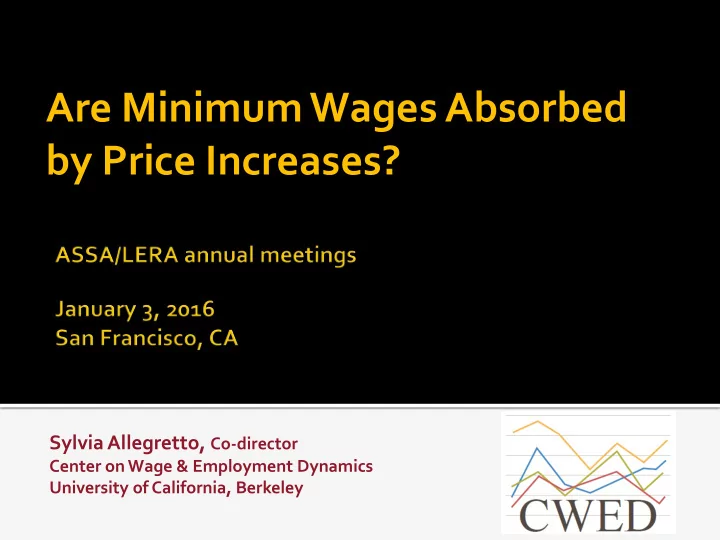

Are Minimum Wages Absorbed by Price Increases? Sylvia Allegretto, Co-director Center on Wage & Employment Dynamics University of California, Berkeley
• Motivated by San Jose State University students November 2012, ballot initiative passed by 59 percent March 2013 one step increase from $8 to $10, affecting over 20 percent of SJ covered workers (Reich 2012) versus 6 percent in all state and federal increases since 1990 (Autor, Manning & Smith 2015) • Great opportunity for a local quasi-experiment First study on price effects of a citywide MW policy Use of internet-based data to compile a unique data set Study restaurant menu prices given RIs use of MW workers San Jose location within a larger labor market
Santa Clara County California San Jose Santa Clara County
Wages Employment Outside SJ San Jose
Sample process N Santa Clara County active food facilities 5,747 Screen for full- and limited-service restaurants 3,285 Restaurants with online menus—first wave 1,211 Restaurants with online menus—second wave 1,009 Final sample of restaurants with menu pairs 884 EVERY Pre- & Post-MENU ITEM WAS DIGITIZED!! (n = 60,509)
From the Santa Clara County AFF List: Name, exact address, phone number Three employee size bins: 1-7, 8-39 & 40+. From recoding: Full-service or limited service Chain or independent Number of menu items Distance to the San Jose border Restaurant density Additional coding of 3 main dishes: Chicken N=7,291 for chicken dishes, Hamburger N=899 Pizza N=644
AFF List Sample A. Distribution San Jose 0.44 0.37 Number of observations 1,460 326 Outside-San Jose 0.56 0.63 Number of observations 1,825 558 B. Distribution by employment size bins San Jose 1-7 employees 0.63 0.58 8-39 employees 0.31 0.33 40+ employees 0.07 0.09 Outside-San Jose 1-7 employees 0.56 0.52 8-39 employees 0.37 0.39 40+ employees 0.07 0.08
Eq. 1: basic model • Eq. 2+: build on basic model •
Elasticities (se) A. Overall 0.058*** (0.016) B. Sector Full-service 0.040** (0.019) Limited-service 0.083*** (0.027) Significance levels: ***1%, **5%, *10%
Elasticities (se) C. Chain analyses 1. Indicator for chain using the whole sample Chain (at least two locations) 0.098*** (0.030) Non-chain 0.030* (0.016) 2. Sample using only chains with outlets in both the treatment and control areas Within-chain effect 0.062** (0.027) Significance levels: ***1%, **5%, *10%
San Jose Outside San Jose (treatment area) (control area)
Dark blue high price change Light blue low price change
Net payroll increase = earnings elasticity (0.20 DLR) less 15 percent reduction in hiring and retention costs (turnover). 0.20*0.85=0.17 To get cost pressure, multiply the net payroll increase by the labor share of operating costs (one-third in restaurants). 0.17*(1/3)= 0.057 percent Thus, our estimated price elasticity of 0.058 along with the cost increase to restaurants of 0.057 suggests a full-price pass through.
SJ restaurant price elasticity overall = 0.058 0.040 for FS restaurants, 0.083 for LS restaurants 0.077 for small, 0.039 for mid-size, 0.008 for small 0.098 and 0.030 for chains and non-chains 0.062 for within-chain estimate Border effects Restaurant density matters Cost of MW increase was absorbed by price increases
Do our results extend to restaurants without an internet presence? Need data on market basket—quantities of each purchased item– for proper weights Revisit preliminary result of no employment effect Cost pressure depends on wage effects, which are imprecisely estimated.
Improve local earnings and employment elasticity estimates with updated data Scraping of internet data a feasible approach to studying restaurant price patterns and MW effects Scrape data from Grub-Hub and similar sites such as Oakland, LA, other cities
“Are Local Minimum Wages Absorbed by Price Increases? Estimates from Internet-based Restaurant Menus” by Sylvia Allegretto & Michael Reich
Recommend
More recommend